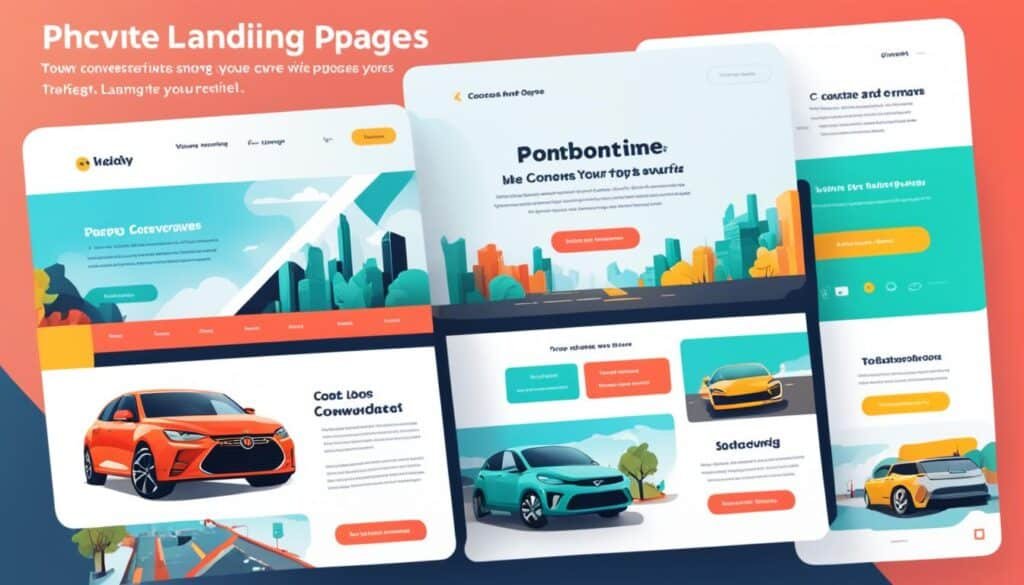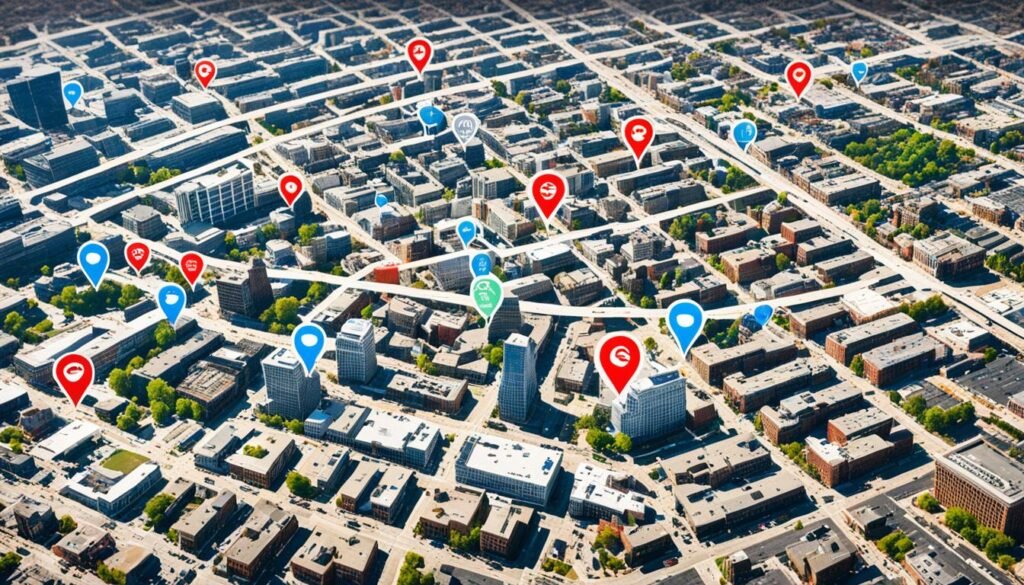Managing high traffic on your website is essential for ensuring a smooth user experience and maximizing your online visibility. By implementing effective strategies, you can optimize your website, attract more visitors, and boost website traffic. Let’s explore some key strategies that can help you handle high traffic and improve search engine rankings.
Key Takeaways:
- Implement strategies to optimize your website and handle high traffic.
- Optimize your content with relevant keywords to improve search engine rankings.
- Create targeted landing pages to enhance visitor engagement and increase conversions.
- Craft engaging, high-quality content to attract and retain website visitors.
- Utilize digital ads on social media platforms to drive targeted traffic to your website.
Optimize Your Content with Keywords
One strategy to handle high traffic is to optimize your content with keywords. This process, known as search engine optimization (SEO), involves using relevant keywords in your website content to make it easier for search engines to find and rank your site. By knowing the search terms people use to discover your website, you can draw in more visitors. Tools like Google Analytics and Google Search Console can help you identify keywords and track search results.
When it comes to online content, keywords play a vital role in attracting website visitors and improving search engine rankings. By strategically incorporating keywords that align with your target audience’s search terms, you can optimize your content to enhance its visibility in search results.
- Identify your target keywords: Conduct keyword research using tools like Google Keyword Planner, SEMrush, or Moz’s Keyword Explorer. Look for keywords that have a high search volume and low competition.
- Place keywords strategically: Once you’ve identified your target keywords, incorporate them naturally throughout your content. Be sure to include them in your headings, subheadings, meta tags, URLs, and within the body of your content.
- Avoid keyword stuffing: While it’s important to optimize your content with keywords, it’s equally important to use them in moderation. Keyword stuffing, or overusing keywords, can have a negative impact on your search engine rankings and make your content appear spammy.
- Write for your audience: While keywords are important for SEO, it’s crucial to remember that your content should ultimately serve your website visitors. Focus on creating high-quality, engaging content that provides value to your readers.
Optimizing your content with keywords not only improves your search engine rankings, but it also helps search engine users find the information they’re looking for. By understanding the search terms people use, you can tailor your content to meet their needs and attract more website visitors.
Create Targeted Landing Pages

To handle high traffic effectively, it is essential to create targeted landing pages. By directing website visitors to dedicated landing pages tailored to their specific interests or needs, you can significantly enhance engagement and increase the likelihood of conversion. Personalized and relevant content on these pages helps visitors find the information they are looking for efficiently, making them more likely to take action.
Targeted landing pages serve as valuable touchpoints in your marketing strategy, allowing you to connect with your audience on a deeper level. By understanding their needs and preferences, you can create a more personalized user experience that resonates with their interests.
These landing pages provide an opportunity to showcase your products or services, highlight key features and benefits, and address any pain points your audience may have. By tailoring the message to specific segments of your audience, you can effectively communicate the value your business offers.
Moreover, targeted landing pages enable you to optimize your marketing efforts. With well-crafted landing pages, you can create a seamless transition from your marketing campaigns, ensuring consistency in messaging and maximizing the impact of your ad spend.
In addition to enhancing engagement and conversions, targeted landing pages play a crucial role in content personalization. By analyzing user behavior, demographics, and preferences, you can dynamically tailor the content on your landing pages to create a more personalized experience for each visitor.
“Targeted landing pages serve as valuable touchpoints in your marketing strategy, allowing you to connect with your audience on a deeper level.”
By implementing marketing automation tools, you can further optimize your targeted landing pages. These tools enable you to deliver personalized content, offers, and calls-to-action based on each visitor’s interaction with your website. This personalized approach not only enhances the user experience but also increases the chances of conversion.
Overall, creating targeted landing pages is an effective strategy to handle high traffic and improve the overall performance of your website. By providing a personalized experience, engaging visitors, and delivering relevant content, you can effectively drive conversions and achieve your marketing goals.
Benefits of Creating Targeted Landing Pages
- Enhanced engagement with website visitors
- Increased likelihood of conversion
- Personalized user experience
- Optimized marketing campaigns
- Improved content personalization
- Higher conversion rates
Craft Engaging, High-Quality Content

Engaging and high-quality content plays a crucial role in handling high traffic on your website. Not only does it attract visitors, but it also establishes your website’s authority and positions your business as an industry leader. By optimizing your content and providing valuable information, you can improve your search engine rankings and increase the likelihood of repeat visitors.
In today’s digital landscape, users are looking for content that captivates their attention, provides relevant information, and keeps them coming back for more. Crafting engaging content requires a deep understanding of your target audience and their needs. By addressing their pain points and providing solutions through your content, you can create a sense of trust and credibility.
High-quality content goes beyond engaging headlines and eye-catching visuals. It encompasses well-researched information, expert insights, and accurate data. By delivering content that adds value to your audience’s lives, you position yourself as a reliable source of information in your industry.
Engaging and high-quality content not only attracts visitors to your website but also establishes your website’s authority and positions your business as an industry leader.
When crafting your content, it is essential to optimize it for search engine optimization (SEO) efforts. Incorporating relevant keywords, meta tags, and structured data allows search engines to understand and index your content effectively. This optimization improves your website’s visibility, search engine rankings, and overall organic traffic.
Additionally, high-quality content encourages repeat visitors. When users find value in your content, they are more likely to bookmark your website, subscribe to your newsletter, and share your articles or blog posts with others. This increased engagement not only drives more traffic but also helps solidify your website as a go-to resource in your industry.
Benefits of Crafting Engaging, High-Quality Content:
- Establishes website authority and industry leadership
- Improves search engine rankings and visibility
- Attracts and retains repeat visitors
- Boosts user engagement and interaction
- Increases brand credibility and trust
- Drives organic traffic through SEO efforts
Best Practices for Crafting Engaging, High-Quality Content:
- Research your target audience to understand their interests and needs
- Create compelling headlines and introductions to capture attention
- Use storytelling techniques to evoke emotions and connect with readers
- Incorporate visuals, such as images and videos, to enhance engagement
- Provide accurate and up-to-date information supported by credible sources
- Deliver actionable insights and practical tips for your audience to implement
- Optimize content for SEO by incorporating relevant keywords and meta tags
- Encourage social media sharing and engagement with share buttons and calls to action
- Regularly update and refresh your content to ensure its relevance and accuracy
By prioritizing the creation of engaging and high-quality content, you can not only attract more visitors to your website but also keep them coming back for more. This will solidify your online presence, strengthen your website’s authority, and boost your SEO efforts in the long run.
Utilize Digital Ads

Digital ads are a powerful tool for driving targeted website traffic. By strategically placing ads on websites or blogs that attract your specific audience, you can effectively increase your website’s visibility and attract more visitors. Social media platforms such as Facebook and Instagram offer targeted ad options based on demographics and interests, allowing you to reach your desired audience with precision.
Working with a consultant or agency can help you develop and optimize your digital ad strategy, ensuring that it aligns with your goals and objectives. They can help you identify the best platforms and channels to reach your target audience and create engaging ad content that resonates with them.
One of the key advantages of digital ads is the ability to target in-market audiences. These are people who have shown a specific interest or intent related to your product or service. By leveraging digital ad platforms, you can reach these potential customers and drive them to your website.
Digital ads provide valuable data and insights into campaign performance. You can track metrics such as impressions, clicks, conversions, and engagement to measure the effectiveness of your ads. Analyzing these metrics helps you understand which ads are performing well and which need optimization, allowing you to refine your strategy for better results.
“Digital ads offer precise targeting options, enabling businesses to connect with their targeted audience, drive website traffic, and ultimately boost conversions.”
Digital Ad Performance Tracking Example
| Metrics | Ad Campaign A | Ad Campaign B |
|---|---|---|
| Impressions | 100,000 | 150,000 |
| Clicks | 2,000 | 3,000 |
| Conversions | 50 | 75 |
| Click-Through Rate (CTR) | 2% | 2% |
| Conversion Rate | 2.5% | 2.5% |
| Cost per Click (CPC) | $1.50 | $1.50 |
The table above illustrates the performance metrics for two digital ad campaigns, A and B. Both campaigns had similar click-through rates (CTR) and conversion rates. However, campaign B had a higher number of impressions, clicks, and conversions. Despite the similar performance, campaign B reached a larger audience and generated more website traffic.
By continuously monitoring and analyzing your digital ad campaigns, you can make data-driven decisions to optimize your ad spend, reach your targeted audience, and drive website traffic.
Leverage Local Search

To capitalize on local traffic, it’s important to optimize your website for local search. By incorporating location-specific keywords and information on your website, you can attract visitors in your geographic area and improve your search engine rankings. Additionally, encouraging customer testimonials and positive online reviews can strengthen your online reputation and attract local customers.
Optimize with Location-Specific Keywords
One of the key strategies for leveraging local search is to incorporate location-specific keywords throughout your website. By including relevant city or region names, you can target users who are searching for local services or businesses in your area. Use tools like Google Keyword Planner to identify location-specific keywords with high search volume.
“Optimizing your website for local search means including location-specific keywords throughout your web pages.”
Provide Location Information
In addition to using location-specific keywords, it’s essential to provide clear and accurate location information on your website. Include your business address, phone number, and operating hours on your contact page and footer. This information not only helps search engines understand your business’s geographic relevance but also makes it easy for local customers to find and contact you.
“Make sure to provide accurate location information, including your business address and phone number, to help potential customers find you.”
Encourage Customer Testimonials and Reviews
Customer testimonials and online reviews play a crucial role in attracting local customers and building trust. Display positive customer testimonials prominently on your website and encourage satisfied customers to leave reviews on popular review platforms such as Google My Business, Yelp, or industry-specific directories. These testimonials and reviews not only help improve your online reputation but also influence potential customers’ decision to choose your business.
“Customer testimonials and reviews are essential for building trust with local customers and improving your online reputation.”
Utilize Local Business Directories
Listing your business on local directories can significantly boost your local search visibility. Register your business on popular directories such as Google My Business, Bing Places for Business, Yelp, and Yellow Pages. Ensure that your business information is consistent across all directories and optimize your listings with relevant keywords and compelling descriptions.
“Increase your visibility in local search by listing your business on popular local directories and optimizing your listings.”
Image: Leverage Local Search
Utilize Email Marketing

Email marketing is a powerful tool to drive traffic to your website. By sending regular newsletters or promotional emails, you can engage with your audience and provide them with valuable content or offers.
Sending email newsletters allows you to stay connected with your subscribers, keeping them informed about your latest updates, promotions, and product launches. This helps build brand loyalty and encourages repeat visits to your website.
Promotional emails, on the other hand, enable you to showcase your products or services and entice your audience to make a purchase. By offering exclusive discounts or limited-time offers, you can create a sense of urgency and drive immediate traffic to your website.
Segmenting your email list based on user data is crucial for effectively targeting your audience. By segmenting your audience into specific groups based on their interests, demographics, or purchase history, you can personalize your email content and offers. This increases the relevance of your emails and significantly improves the chances of conversions.
Remember to optimize your email content for mobile devices as well. With a significant percentage of users accessing emails on smartphones and tablets, it’s essential to ensure that your emails are mobile-friendly and provide a seamless user experience across different devices.
To further enhance your email marketing strategy, consider including content offers within your emails. This could include free guides, e-books, or exclusive content that provides additional value to your subscribers. By enticing them with valuable resources, you can attract more traffic to your website and establish yourself as an authority in your industry.
Benefits of Email Marketing for Website Traffic
| Benefits | Description |
|---|---|
| Increased website traffic | Email marketing drives traffic to your website by directing recipients to specific landing pages or promoting your latest content or offers. |
| Targeted audience | Segmenting your email list allows you to send targeted messages to specific groups, increasing the relevance of your emails and driving higher engagement. |
| Improved conversions | By providing personalized content and offers to your subscribers, you can significantly improve the chances of converting them into paying customers. |
| Enhanced brand awareness | Email marketing helps keep your brand top-of-mind with your audience, increasing brand recognition and fostering loyalty. |
By utilizing email marketing effectively, you can drive substantial traffic to your website and nurture relationships with your audience, ultimately boosting conversions and achieving your business goals.
Build Quality Backlinks

Building quality backlinks is crucial for improving your website’s search engine rankings, increasing website authority, and driving referral traffic. Backlinks are links from other websites that lead to your site, and search engines view them as a vote of confidence in your content.
By acquiring quality backlinks from authoritative and reputable websites, you can enhance your website’s credibility and boost its search engine rankings. These backlinks indicate to search engines that your website is a trustworthy source of information, which can lead to higher visibility and attract more organic traffic.
When building backlinks, it’s important to focus on quality rather than quantity. Search engine algorithms prioritize backlinks from reputable websites within your industry or niche. A few high-quality backlinks from authoritative sources can have a more significant impact on your search engine rankings than numerous low-quality backlinks.
Here are some strategies to help you build quality backlinks:
- Guest Blogging: Contribute informative and valuable content to authoritative websites in your industry, including a link back to your website.
- Influencer Collaborations: Partner with influential individuals in your industry to create content and get backlinks from their websites or social media profiles.
- Content Promotion: Share your high-quality content on social media platforms, online communities, and industry forums to attract backlinks from interested users.
- Link Outreach: Reach out to relevant websites and bloggers, offering them valuable content or resources in exchange for a backlink.
Benefits of Quality Backlinks
| Benefits | Description |
|---|---|
| Improved Search Engine Rankings | Quality backlinks signal to search engines that your website is trustworthy and authoritative, leading to higher rankings in search results. |
| Increased Website Authority | Backlinks from reputable websites enhance your website’s authority and credibility in your industry, helping you stand out as a reliable source of information. |
| Referral Traffic | When users click on backlinks from other websites, they are directed to your site, generating referral traffic from a relevant and interested audience. |
By investing time and effort into building quality backlinks, you can improve your search engine rankings, increase your website’s authority, and drive targeted referral traffic. Remember to focus on acquiring backlinks from reputable sources within your industry and engage in ethical and sustainable link-building practices.
Incorporate Social Media Marketing

Social media marketing is a powerful strategy to drive website traffic, promote content, engage with your audience, and increase brand visibility. By utilizing various social media platforms, you can target different demographics and attract visitors to your website. Consistent posting, interactive engagement with your followers, and sharing valuable content are key to boosting your brand’s online presence and driving traffic.
With the rise of social media platforms, businesses have gained access to a vast audience base, making it an ideal channel for marketing and promoting your website. By leveraging social media marketing, you can:
- Reach a wider audience: Social media platforms have millions of users, providing you with the opportunity to connect with potential customers and drive website traffic.
- Build brand awareness: Consistent posting and sharing valuable content on social media platforms help increase brand visibility and recognition.
- Promote your content: Use social media to share your blog posts, articles, videos, and other valuable content, directing traffic to your website.
- Engage with your audience: Interact with your followers, respond to comments and messages, and build meaningful connections with your audience.
- Showcase your expertise: Social media platforms allow you to share industry insights, tips, and thought leadership, establishing your brand as an authority in your niche.
When implementing social media marketing, it’s essential to identify the platforms where your target audience is most active. Focus your efforts on those platforms to maximize engagement and drive website traffic. Additionally, use analytics tools provided by social media platforms to gain insights into your audience’s preferences, interests, and behaviors, enabling you to tailor your content and marketing strategies accordingly.
To illustrate the benefits of social media marketing, consider the following example of a business in the retail industry:
“As a retailer, incorporating social media marketing into our overall marketing strategy has revolutionized our online presence. By actively engaging with our audience on platforms such as Instagram and Twitter, we have witnessed a significant increase in website traffic and brand visibility. Through consistent posting and sharing compelling content, we have managed to create a loyal community of followers who actively promote our brand to their network.”
Incorporating social media marketing into your overall marketing strategy is vital for driving website traffic, promoting content, engaging with your audience, and increasing brand visibility. Consistent and strategic efforts across various social media platforms can yield remarkable results and contribute to the overall success of your business.
Collaborate with Influencers

Collaborating with influencers is a powerful strategy to boost website traffic and increase brand exposure. By partnering with influencers who have a significant audience in your industry, you can tap into their loyal followers and expand your reach. Influencer marketing allows you to leverage the trust and credibility that influencers have built with their audience, making it an effective way to attract visitors to your website.
When collaborating with influencers, it’s important to consider their audience reach and relevance to your brand. Look for influencers whose followers align with your target audience to ensure maximum impact. By choosing the right influencers, you can reach a broader audience that is more likely to be interested in your products or services.
Influencers often promote content, products, or services to their followers, leading to increased website traffic and potential conversions. Their endorsement can generate curiosity and interest among their audience, prompting them to visit your website to learn more or make a purchase.
Benefits of Collaborating with Influencers:
- Increased Audience Reach: Influencers have a dedicated following who trust their recommendations, allowing you to reach a wider audience that may not be aware of your brand.
- Enhanced Brand Exposure: Partnering with influencers gives your brand exposure to their followers, increasing brand awareness and recognition.
- Website Traffic Boost: Influencer collaborations can drive significant traffic to your website as their followers visit to explore recommended content or products.
- Content Promotion: Influencers can help amplify your content by sharing or featuring it on their platforms, reaching a larger audience and increasing content visibility.
To illustrate the impact of influencer marketing, consider the following example:
“We collaborated with a well-known fitness influencer to promote our new line of workout apparel. Through her Instagram posts and stories, she showcased our products in action and shared her personal experience. Her followers, who are fitness enthusiasts and aspiring athletes, were highly engaged and curious about our brand. As a result, our website experienced a 30% increase in traffic during the influencer campaign, and we saw a significant boost in sales.”
In conclusion, collaborating with influencers is an effective strategy to increase website traffic, expand your brand’s reach, and promote your content. By partnering with influencers who have a strong audience in your industry, you can harness their influence to attract visitors to your website and drive conversions.
Utilize Video Marketing

Video marketing is a powerful strategy to drive traffic to your website and engage with your audience. By creating compelling and informative videos, you can captivate viewers’ attention and entice them to visit your website. Whether you choose to incorporate videos directly into your website or promote them on popular platforms like YouTube, video content has the potential to attract new visitors and increase user engagement.
When creating videos for your marketing efforts, it’s essential to optimize them for search engines to maximize their visibility. Implementing video search engine optimization (SEO) tactics will improve your website’s chances of appearing in search results and drive more traffic.
To effectively utilize video marketing, consider the following strategies:
- Create engaging and informative videos that provide value to your target audience.
- Include relevant keywords in your video titles, descriptions, and tags to improve search engine rankings.
- Craft compelling thumbnails that entice viewers to click and watch your videos.
- Share your videos on various platforms, such as your website, social media, and video-sharing sites.
- Encourage viewers to like, comment, and share your videos to boost their visibility and reach.
- Engage with your audience by responding to comments and encouraging discussions around your video content.
By implementing these strategies, you can leverage the power of video marketing to drive website traffic, engage with your audience, and enhance your overall online presence.
In optimizing the scalability and performance of a high-traffic website, especially true for high-traffic areas like entryways, kitchens, and bathrooms, one must consider various pain points such as traffic spikes, stain resistance, and cybersecurity.
Whether deploying a monolithic architecture or microservices, it’s crucial to locate and alleviate bottlenecks through code optimization and system design. Utilizing in-memory caching with technologies like Redis can withstand spikes in traffic, while also employing water-resistant materials like waterproof rugs from Safavieh in high traffic areas can mitigate downtime caused by occurrences such as spills.
Real-time analytics and metrics, especially those related to traffic spikes and user behavior, could measure the effectiveness of changes made to the technology stack. Additionally, implementing features like an API for accessing data structures or deploying Elasticsearch for efficient querying across multiple zones can enhance scalability and performance across the platform. Stakeholders on the business side should be kept informed about the system’s ability to handle a high amount of data and users per second, with regular updates on performance issues and cybersecurity measures.
By constantly monitoring and optimizing the system, one can ensure that the website remains resilient and capable of handling the ever-changing demands of a high-traffic environment, all while maintaining a decorative and inviting user experience.
Also Read : Unlock Traffic Secrets For Massive Web Growth
Conclusion
Implementing effective strategies to handle high traffic and increase website traffic is crucial for improving online visibility and driving more visitors to your site. By optimizing your website, creating targeted landing pages, crafting high-quality content, utilizing digital ads, leveraging local search, incorporating email marketing, building quality backlinks, utilizing social media marketing, collaborating with influencers, and utilizing video marketing, you can drive more traffic to your website and improve its overall performance.
Website optimization plays a vital role in attracting and retaining visitors. By optimizing your content with relevant keywords, you can improve your search engine rankings and increase your website’s visibility. Creating targeted landing pages tailored to specific audiences helps drive engagement and improve conversions by providing personalized content that meets their needs.
Creating engaging, high-quality content not only attracts visitors but also establishes your website’s authority and positions your business as an industry leader. Digital ads allow you to target specific audiences and increase website traffic, while local search optimization ensures that your website appears in local search results, attracting relevant and high-intent visitors.
By incorporating email marketing, you can engage with your audience and provide them with valuable content, driving traffic to your website. Building quality backlinks from authoritative websites helps increase your website’s credibility, search engine rankings, and referral traffic. Social media marketing allows you to reach a wider audience and promote your content, while collaborating with influencers and utilizing video marketing further enhances your online visibility and drives website traffic.
FAQs
Q: What does it mean to have a high-traffic website?
A: Having a high-traffic website refers to a site that experiences a significant amount of traffic or visits from users on a regular basis.
Q: Why is it important to handle high traffic on a website?
A: Managing high traffic is crucial to ensure that the website remains accessible, responsive, and functional for all users, without crashing or experiencing downtime.
Q: What are some common strategies for handling high traffic on a website?
A: Strategies include optimizing server performance, using caching mechanisms, implementing content delivery networks (CDNs), and scaling the infrastructure to handle increased loads.
Q: How can scalability help in managing high traffic on a website?
A: Scalability allows the website to efficiently handle a growing amount of traffic by adapting the resources and infrastructure as needed, ensuring smooth performance even during peak times.
Q: What role does stress testing play in preparing for high traffic on a website?
A: Stress testing involves simulating high volumes of traffic to assess the website’s performance under such conditions, helping to identify bottlenecks and areas for improvement before actual traffic spikes occur.
Q: Why is it essential to monitor and analyze website traffic constantly?
A: Monitoring traffic helps in detecting unusual patterns or spikes, identifying potential security threats, optimizing resources, and making data-driven decisions to enhance the overall user experience.
Q: How can cybersecurity measures help protect a high-traffic website?
A: Implementing cybersecurity protocols such as encryption, firewalls, and regular security audits can safeguard the website from cyber attacks, data breaches, and unauthorized access, ensuring the protection of sensitive information.
Source Links
- https://www.wordstream.com/blog/ws/2014/08/14/increase-traffic-to-my-website
- https://mailchimp.com/resources/5-ways-to-increase-website-traffic/
- https://blog.hubspot.com/marketing/increase-website-traffic





